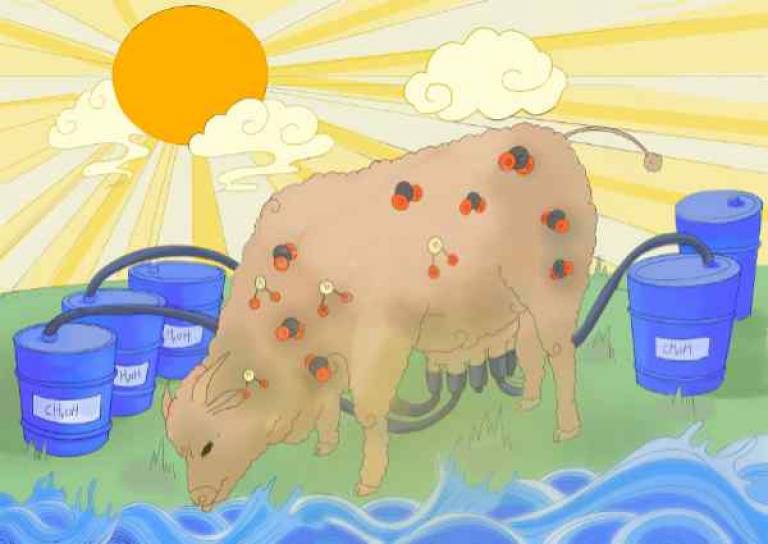CO2 Cow Machine: being included in the online Images of Climate Innovation Exhibition
11 October 2021
An image named CO2 Cow Machine from our group has been included in the online Images of Climate Innovation Showcase, an event in the 26th UN Climate Change Conference of the Parties (COP26) hosted by University of Glasgow in November.

The Climate Innovation Showcase is a sample of the innovative work going on at universities in the UK, showcasing the creativity and endeavour of researchers to develop new ways to reduce greenhouse emissions, adapt life to the changing climate, help us to better understand the nature of the climate and its impacts, and inform action.
The showcase, which comprises an exhibition of climate-related research, as well as a series of events, has been curated by the COP26 Universities Network, an informal association of academics in the UK active on subjects related to climate change, who wanted to work together in support of the aims of the 26th UNFCCC Conference of the Parties, i.e. COP26.
What's this about?
Natural photosynthesis efficiently utilising CO2 triggers us to create an innovative route to recycle CO2. We have designed an earth-abundant carbon-based system to efficiently transform CO2 to methanol with nearly 100% selectivity under artificial light irradiation (resemble a Cow Machine). Such a strategy could be scaled up to close the carbon cycle, providing sustainable fuels and tackling climate change issues caused by increasing greenhouse gas emissions.
More detail about the research
Natural photosynthesis can very efficiently convert CO2 with water to biomass driven by solar energy. Stimulated by this, we have designed a catalytic system driven by either sunlight or an artificial light to convert CO2 and water to liquid fuel methanol operated at room temperature (denote Cow Machine).
By careful design of the carbon-dots/carbon-nitride junction photocatalyst, we show the stable conversion of water and CO2 to methanol with nearly 100% selectivity under artificial light irradiation. The key behind these new exciting results is the unique nature of the crystalline carbon dots prepared via a microwave method. Two photoreactions are driven by the cow machine simultaneously: 1) H2O oxidation and 2) CO2 reduction to high-value products, in this case, methanol (CH3OH).
The performance of the cow machine relies on co-catalysts to selectively accelerate the reaction rates. What we developed is the crystalline carbon dots, which serve as the cocatalyst, leading to 6 times enhanced lifetime of charge carriers. Computational results also proved such long-lived charge carriers favour liquid fuel production, consistent with the exceptional near 100% selectivity to methanol with high quantum yield. This strategy selectively reduces greenhouse gas by water to high-value chemicals, hence offering sustainable liquid fuels and closing the global carbon cycle. Both the photocatalyst and cocatalyst can be readily scaled up and the Cow Machine can be operated either under sun irradiation or indoor artificial light irradiation, promising a very safe and moderate reaction condition.
For more details on this study, please see our recent article 'Unique hole-accepting carbon-dots promoting selective carbon dioxide reduction 100% to methanol by pure water' published in Nature Communications.
The entry can be viewed here.
 Close
Close

